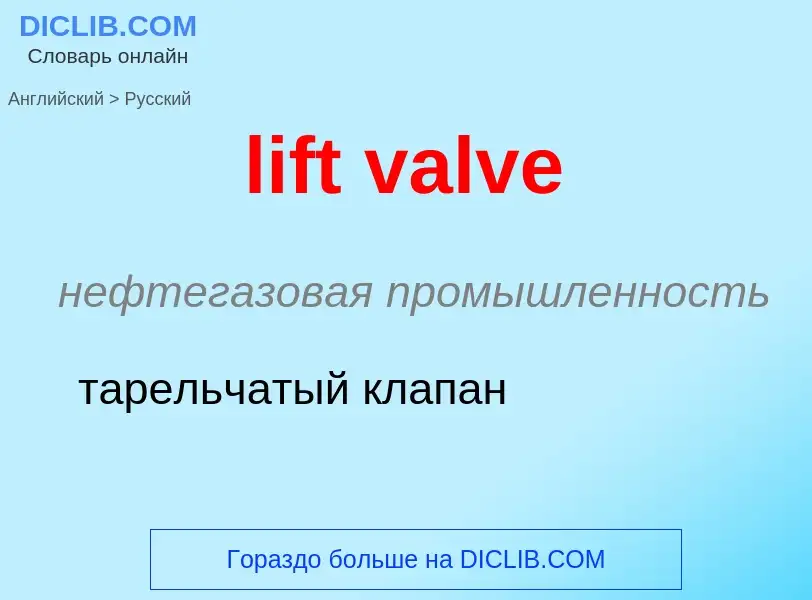Перевод и анализ слов искусственным интеллектом ChatGPT
На этой странице Вы можете получить подробный анализ слова или словосочетания, произведенный с помощью лучшей на сегодняшний день технологии искусственного интеллекта:
- как употребляется слово
- частота употребления
- используется оно чаще в устной или письменной речи
- варианты перевода слова
- примеры употребления (несколько фраз с переводом)
- этимология
lift valve - перевод на русский
нефтегазовая промышленность
тарельчатый клапан
общая лексика
подъем клапана
строительное дело
ход клапана
нефтегазовая промышленность
подъём клапана
общая лексика
пространственное течение
нефтегазовая промышленность
впускной клапан
всасывающий клапан
физика
сила подъемная
строительное дело
подъёмная сила
Википедия

A valve is a device or natural object that regulates, directs or controls the flow of a fluid (gases, liquids, fluidized solids, or slurries) by opening, closing, or partially obstructing various passageways. Valves are technically fittings, but are usually discussed as a separate category. In an open valve, fluid flows in a direction from higher pressure to lower pressure. The word is derived from the Latin valva, the moving part of a door, in turn from volvere, to turn, roll.
The simplest, and very ancient, valve is simply a freely hinged flap which swings down to obstruct fluid (gas or liquid) flow in one direction, but is pushed up by the flow itself when the flow is moving in the opposite direction. This is called a check valve, as it prevents or "checks" the flow in one direction. Modern control valves may regulate pressure or flow downstream and operate on sophisticated automation systems.
Valves have many uses, including controlling water for irrigation, industrial uses for controlling processes, residential uses such as on/off and pressure control to dish and clothes washers and taps in the home. Even aerosol spray cans have a tiny valve built in. Valves are also used in the military and transport sectors. In HVAC ductwork and other near-atmospheric air flows, valves are instead called dampers. In compressed air systems, however, valves are used with the most common type being ball valves.


![The shut off butterfly valve for a [[Francis turbine]] at [[Gordon Power Station, Tasmania]] The shut off butterfly valve for a [[Francis turbine]] at [[Gordon Power Station, Tasmania]]](https://commons.wikimedia.org/wiki/Special:FilePath/Gordon Power Station Control Valve.jpg?width=200)
![[[Ball valve]] [[Ball valve]]](https://commons.wikimedia.org/wiki/Special:FilePath/Valve-balls-The-Alloy-Valve-Stockist.jpg?width=200)
![[[Globe valve]] [[Globe valve]]](https://commons.wikimedia.org/wiki/Special:FilePath/Globe valve (rendered).jpg?width=200)
![A valve controlled by a [[wheel]] (on vertical line) A valve controlled by a [[wheel]] (on vertical line)](https://commons.wikimedia.org/wiki/Special:FilePath/Green tubes and valves.jpg?width=200)
![Large [[butterfly valve]] Large [[butterfly valve]]](https://commons.wikimedia.org/wiki/Special:FilePath/Nasa-space-18408-l.jpg?width=200)
![Cast iron [[butterfly valve]] Cast iron [[butterfly valve]]](https://commons.wikimedia.org/wiki/Special:FilePath/Bidirectional tight butterfly valve-The-Alloy-Valve-Stockist.jpg?width=200)
![Hastelloy [[ball valve]] Hastelloy [[ball valve]]](https://commons.wikimedia.org/wiki/Special:FilePath/Hastelloy Ball valve.jpg?width=200)
![Stainless steel [[gate valve]] Stainless steel [[gate valve]]](https://commons.wikimedia.org/wiki/Special:FilePath/Valve.jpg?width=200)
![Inside view of a tilting disc inconel [[check valve]] Inside view of a tilting disc inconel [[check valve]]](https://commons.wikimedia.org/wiki/Special:FilePath/Inside-tilting-disc-check-valve-The-Alloy-Valve-Stockist.jpg?width=200)
![Large carbon steel swing [[check valve]] Large carbon steel swing [[check valve]]](https://commons.wikimedia.org/wiki/Special:FilePath/Large-swing-check-valve-The-Alloy-Valve-Stockist.jpg?width=200)
![Disc for an alloy [[check valve]] also known as axial check valve Disc for an alloy [[check valve]] also known as axial check valve](https://commons.wikimedia.org/wiki/Special:FilePath/Nozzle-check-valve-disc-The-Alloy-Valve-Stockist.jpg?width=200)

![Ball for a titanium [[ball valve]] Ball for a titanium [[ball valve]]](https://commons.wikimedia.org/wiki/Special:FilePath/Ball-valve-ball-The-Alloy-Valve-Stockist.jpg?width=200)

![Oscillating poppet valve on one of Chapelon's rebuilt [[4-6-2]] locomotives. Oscillating poppet valve on one of Chapelon's rebuilt [[4-6-2]] locomotives.](https://commons.wikimedia.org/wiki/Special:FilePath/231-E-41-d.jpg?width=200)
![Poppet valves in a typical [[overhead camshaft engine]] Poppet valves in a typical [[overhead camshaft engine]]](https://commons.wikimedia.org/wiki/Special:FilePath/4StrokeEngine Ortho 3D Small.gif?width=200)



.jpg?width=200)

![streamlines]]. streamlines]].](https://commons.wikimedia.org/wiki/Special:FilePath/Karman trefftz.gif?width=200)

